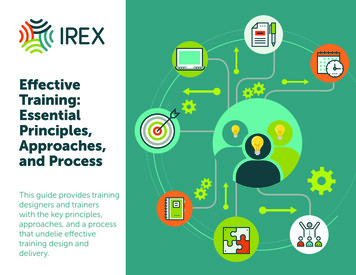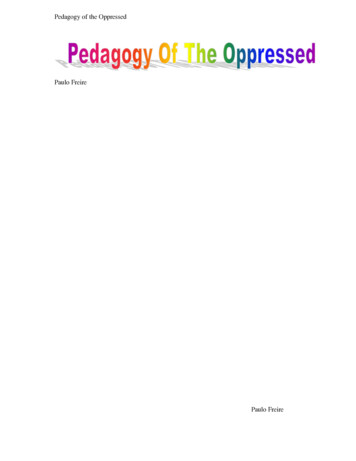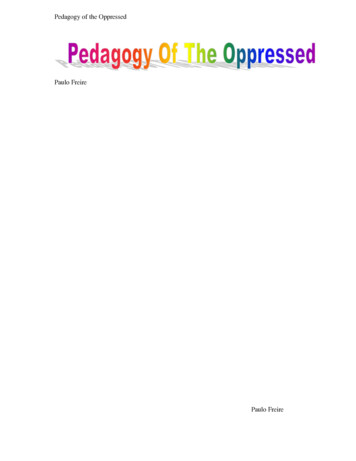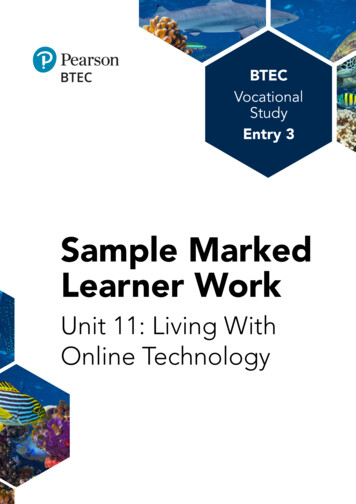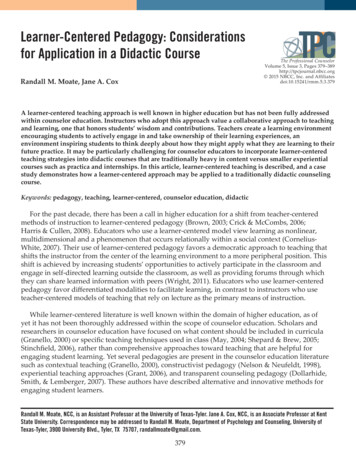
Transcription
Learner-Centered Pedagogy: Considerationsfor Application in a Didactic CourseRandall M. Moate, Jane A. CoxThe Professional CounselorVolume 5, Issue 3, Pages 379–389http://tpcjournal.nbcc.org 2015 NBCC, Inc. and Affiliatesdoi:10.15241/rmm.5.3.379A learner-centered teaching approach is well known in higher education but has not been fully addressedwithin counselor education. Instructors who adopt this approach value a collaborative approach to teachingand learning, one that honors students’ wisdom and contributions. Teachers create a learning environmentencouraging students to actively engage in and take ownership of their learning experiences, anenvironment inspiring students to think deeply about how they might apply what they are learning to theirfuture practice. It may be particularly challenging for counselor educators to incorporate learner-centeredteaching strategies into didactic courses that are traditionally heavy in content versus smaller experientialcourses such as practica and internships. In this article, learner-centered teaching is described, and a casestudy demonstrates how a learner-centered approach may be applied to a traditionally didactic counselingcourse.Keywords: pedagogy, teaching, learner-centered, counselor education, didacticFor the past decade, there has been a call in higher education for a shift from teacher-centeredmethods of instruction to learner-centered pedagogy (Brown, 2003; Crick & McCombs, 2006;Harris & Cullen, 2008). Educators who use a learner-centered model view learning as nonlinear,multidimensional and a phenomenon that occurs relationally within a social context (CorneliusWhite, 2007). Their use of learner-centered pedagogy favors a democratic approach to teaching thatshifts the instructor from the center of the learning environment to a more peripheral position. Thisshift is achieved by increasing students’ opportunities to actively participate in the classroom andengage in self-directed learning outside the classroom, as well as providing forums through whichthey can share learned information with peers (Wright, 2011). Educators who use learner-centeredpedagogy favor differentiated modalities to facilitate learning, in contrast to instructors who useteacher-centered models of teaching that rely on lecture as the primary means of instruction.While learner-centered literature is well known within the domain of higher education, as ofyet it has not been thoroughly addressed within the scope of counselor education. Scholars andresearchers in counselor education have focused on what content should be included in curricula(Granello, 2000) or specific teaching techniques used in class (May, 2004; Shepard & Brew, 2005;Stinchfield, 2006), rather than comprehensive approaches toward teaching that are helpful forengaging student learning. Yet several pedagogies are present in the counselor education literaturesuch as contextual teaching (Granello, 2000), constructivist pedagogy (Nelson & Neufeldt, 1998),experiential teaching approaches (Grant, 2006), and transparent counseling pedagogy (Dollarhide,Smith, & Lemberger, 2007). These authors have described alternative and innovative methods forengaging student learners.Randall M. Moate, NCC, is an Assistant Professor at the University of Texas-Tyler. Jane A. Cox, NCC, is an Associate Professor at KentState University. Correspondence may be addressed to Randall M. Moate, Department of Psychology and Counseling, University ofTexas-Tyler, 3900 University Blvd., Tyler, TX 75707, randallmoate@gmail.com.379
The Professional Counselor/Volume 5, Issue 3Teaching practices such as contextual teaching, constructivist pedagogy, experiential teachingapproaches and transparent counseling pedagogy share commonalities with, and reflect certainideals of, learner-centered pedagogy. We believe that learner-centered pedagogy could representan overarching theoretical umbrella, under which previous teaching practices presented in thecounseling literature could represent different forms of learner-centered instruction. In this way,learner-centered pedagogy may serve as a conceptual framework that educators can use to providean impactful learning experience for counseling students.We provide a brief description of the learning needs of counselor education students based onthe demands they will face working as professional counselors, followed by an explanation of howlearner-centered pedagogy may ultimately help professional counselors meet these demands. A casestudy is then presented to demonstrate how learner-centered pedagogy was applied in a couplescounseling class.Preparing Counselor Trainees for Professional Practice: Facilitating Deep LearningMaster’s degree programs in counselor education are designed to prepare students to beginworking as professional counselors upon graduation. To learn to be professional counselors, studentsmust develop a sense of comfort with ambiguity and a capacity for independent and reflectivethinking (Dollarhide et al., 2007). Counseling students also must develop competent clinical skills andadequate knowledge to pass licensure examinations. Traditionally, courses thought to be didactic(e.g., theories, ethics, diagnosis, couples and family counseling) have tended to emphasize theacquisition of important content knowledge. In contrast, seminar courses (e.g., prepracticum,practicum, internship) are oriented to experiential learning and the development of clinical skills(Sperry, 2012). Counselor educators have designed curricula with the dual focus of acquiringimportant content knowledge and the development of clinical skills. Yet it is unclear what approachesto teaching are helpful for preparing counselor trainees for the demands of being a professionalcounselor, particularly approaches to teaching didactic courses.One means of gaining insight into this question of helpful teaching approaches to didactic orseminar courses is to explore what counseling students and practicing counselors believe is importantin their training. A comprehensive review of the literature revealed only a few articles that offer someevidence of what students and practicing counselors perceive as important learning experiencesduring their graduate degree programs, experiences that help to prepare them for professionalcounseling careers. Orlinsky, Botermans, Rønnestad, and the SPR Collaborative Research Network(2001) found that professional therapists recall practical and experiential learning as most helpful infacilitating their professional development. Similarly, Furr and Carroll (2003) found that experientiallearning activities and activities that involve immediate application of knowledge have a greaterimpact on students’ development than cognitive teaching strategies. Grant (2006) supported theseresearch findings; she posited that counselor education programs should expand beyond didacticintensive approaches to teaching to incorporate more opportunities for experiential learning andactivities that generate reflective thinking. Grant surmised that these approaches to teaching arehelpful for preparing counselor trainees for the complexity of working with challenging clientpopulations.Experiential and applied learning are important facets of learner-centered pedagogy that can helpinstructors move away from didactic-intensive styles of teaching and enhance deeper approaches tolearning in their students. Researchers have identified a deep approach as one of two approaches380
The Professional Counselor/Volume 5, Issue 3students take toward learning (Diseth, 2007; Parpala, Lindblom-Ylänne, Komulainen, Litmanen, &Hirsto, 2010). A deep approach toward learning is characterized by students’ intent to understand therichness and meaning of what they are studying (Diseth, 2007). The second is a surface approach,which prioritizes the reproduction of knowledge with precision rather than depth of understanding,as students’ motivation tends to be based on minimizing their chances of being wrong (Parpala et al.,2010). A surface approach to learning can be compared to the processes of a copying machine—students are presented with information, which they attempt to reproduce neatly and accurately, sothat the copy mirrors the original as closely as possible. Students who adopt a deep approach towarda learning task are typically regarded as having intrinsic motivations for learning (Diseth, 2007). Suchstudents are more likely to conceptualize, problem solve, and be reflective during a learning task asthey wrestle to construct personal knowledge and understanding.Students’ perception of their learning environment is a factor that influences the type of learningapproach they use during the course. Some researchers have found a positive correlation betweenlearner-centered classroom environments and students developing deep approaches to learning(Vanthournout, Donche, Gijbels, & Van Petegem, 2004; Wilson & Fowler, 2005). Students who havepositive perceptions of a learning environment (e.g., see meaning and purpose in a course, perceivethat what they are learning will be useful to them, are stimulated by classroom activities, perceive theclassroom as a safe place) tend to adopt deep approaches toward learning. Students who hold anegative perception of a learning environment (e.g., do not see purpose or meaning in a course, arenot intellectually stimulated, struggle to grasp what is being taught, feel unsafe or overwhelmed inthe classroom) are more likely to adopt surface approaches toward learning (Lindblom-Ylänne, 2004).Counselor educators are tasked with creating an engaging learning environment in didacticoriented classes that invites students to learn thoughtfully and deeply as they prepare forprofessional counseling practice. Creating an environment that counseling students perceive asmeaningful, useful and safe may encourage students to use deep approaches to learning. Counselingstudents who use a deep approach toward their learning may develop greater personal meaning andunderstanding about what they are learning, so they can more effectively apply what they havelearned when working as professional counselors. Aspects of leaner-centered pedagogy may beuseful to counselor educators in creating a learning environment that is perceived as positive bycounseling students, whether in the context of a didactic or seminar course.Teacher-Centered and Learner-Centered PedagogiesA factor that can influence how counselor trainees perceive their learning environment is theteaching approach used by their instructor. Teacher-centered and learner-centered pedagogies arediffering approaches to teaching that are based on contrasting ideological assumptions.Teacher-Centered PedagogyTeacher-centered pedagogy is associated with traditional conceptions of teaching in whichinstructors prioritize acquiring pertinent content knowledge as a primary learning objective (Brown,2003). The teacher is the fulcrum of the learning environment, having a greater wealth of knowledgeabout the subject being taught, relative to students’ inexperience and lack of knowledge (Wright,2011). This distinction can engender a hierarchical relationship between teacher and students in theclassroom. Teacher-student relationships primarily are defined by intellectual explorations chosen bythe teacher, in which the teacher is an arbiter and distributor of knowledge and students are receiversof knowledge (Wright, 2011).381
The Professional Counselor/Volume 5, Issue 3Instructors using a teacher-centered approach predominantly rely on lecture to transmitknowledge to students, and typically prioritize the acquisition of content, as students are evaluatedon their ability to accurately reproduce knowledge that they are provided (Brown, 2003). Whilelecturing is acknowledged in the literature as a tool that can be helpful for stimulating studentlearning, instructors who rely heavily on lecture-intensive approaches have come under criticism andhave been linked with students adopting surface approaches to learning (Diseth, 2007). Bain (2004)cautioned that instructors’ use of didactic-intensive forms of instruction may stunt students’ curiosityand appetite for learning, as students may become accustomed to being passive receptacles forinformation. Various authors in the counseling literature have posited that supplementing lecturewith alternative or innovative teaching approaches can help engage student learning so that studentscan more effectively access and apply what they have learned in their work as professionalcounselors (May, 2004; Shephard & Brew, 2005; Stinchfield, 2006).Learner-Centered PedagogyLearner-centered pedagogy emerged from constructivist learning theory and represents acountermovement to traditional teacher-centered pedagogical practices (Baeten, Dochy, & Struyven,2012; McAuliffe & Eriksen, 2002). Educators who use learner-centered pedagogy view knowledgethrough lenses of social and relational processes and therefore prioritize students’ individualprocesses of constructing personal knowledge and understanding rather than rote mastery of coursecontent (Baeten et al., 2012). These instructors must be comfortable with the uncertainty and neededflexibility that come with self-reflection and change, both in themselves and their students (McAuliffe& Eriksen, 2002). Such instructors place learning at the center of the classroom environment, whereboth teacher and students share responsibility for creating a meaningful learning experience. Incontrast, teacher-centered instructors assume the majority of responsibility for teaching and ensuringthat learning is occurring, and they represent the most prominent aspect of the learning environmentrather than having that space filled by the topic of interest.The primary task of an instructor using a learner-centered approach is to create an environmentthat is conducive to learning. Although a strong grasp of course content and use of lecture may behelpful in this endeavor, they represent only two of several important components of such a learningenvironment. Brown (2003) stated that the focus on the process of learning and the context in whichlearning occurs is considered to be as integral as, or more integral than, the specific contentknowledge presented to students. McCombs (as cited in Cornelius-White, 2007) described somecharacteristics of learning environments that are based on learner-centered assumptions:[Learning is] non-linear, recursive, continuous, complex, relational, and naturalin humans. . . . Learning is enhanced in contexts where learners have supportiverelationships, have a sense of ownership and control over learning processes, andcan learn with and from each other in safe and trusting learning environments.(p. 7)Two important components that learner-centered teachers consider when establishing a positivelearning environment are providing supportive relationships in the classroom and creating a spacethat feels safe and trusting to student learners (Weimer, 2002). Instructors using a learner-centeredapproach foster supportive relationships and cultivate a safe learning environment by diffusingpower differentials between the teacher and students. Instructors diffuse power differentials throughintentionally creating opportunities for students to become active in the classroom, honoring and382
The Professional Counselor/Volume 5, Issue 3utilizing student learners’ individual experiences and perspectives, and treating students as partnersin the learning process (Crick & McCombs, 2006). Thus, instead of the instructor being the primaryarbiter of content, intellectual queries and structure in a classroom, a learner-centered instructorfavors democratic and collaborative approaches to teaching that empower students to be activeparticipants in their learning (Wright, 2011). An example of this practice occurs when an instructorintentionally defers from immediately answering a student’s question and rather redirects thequestion to the students in the classroom. Such an approach diminishes the instructor’s role as“expert” in the classroom; connotes a belief that student learners possess the collective knowledge,experiences and perspectives to provide useful insight to answer the question; and encouragesstudents to become intellectually active in the classroom.Such collaborative learning is an important aspect of learner-centered teaching since collaborationis a social process believed to help students develop problem-solving skills, challenge their beliefsthrough honoring many viewpoints in the classroom and construct deeper personal understandingsof course content (Brown, 2003). Instructors can nurture collaborative relationships by following twolearner-centered principles: students prefer to have a sense of ownership and control over theirlearning experiences, and students should receive opportunities to teach each other what they havelearned (Weimer, 2002). Therefore, student learners’ preferences and opinions are taken into accountwhen possible during course planning (e.g., having a class discussion about setting class rules) andwhen selecting reading assignments or major course projects (e.g., allowing student learners to createtheir own projects; providing student learners with a variety of assignments from which to selecttheir course projects). Student learners then perceive that they are able to shape their learningexperience in a meaningful way. After students have engaged in self-directed learning projectsoutside the classroom, they are then given opportunities to deepen their learning through sharingwhat they have learned with their classmates (Brown, 2003).In addition to increased autonomy to construct their learning experiences, student learners receiveautonomy to pursue areas of intellectual interest in the classroom. Learner-centered instructorsprovide opportunities for their students to explore topics of interest in depth by adhering less strictlyto course content (Baeten, Struyven, & Dochy, 2013). Course content is used as a starting point forstimulating intellectual exploration in students. Students are encouraged to explore content andtopics of interest when their instructors create space for inquiry, discussion or other spontaneouslearning experiences in the classroom (Weimer, 2002). Thus, learner-centered instructors favor flexibleapproaches to teaching that create space for students to learn about topics of interest with greaterdepth, rather than teacher-centered approaches that ensure a broad coverage of course content.Student learners’ active role and sense of autonomy during class is counterbalanced by learnercentered instructors taking a more peripheral role, acting as guides who encourage students on theirown path of inquiry and understanding (Wright, 2011). Teachers using a learner-centered approachhelp facilitate students’ learning interests as they arise by guiding discussion and inquiry, whilebeing mindful to incorporate various learning experiences in the classroom. Incorporating flexibleand varied teaching practices (e.g., lecture, multimedia, experiential activities, discussion) is a keyaspect of facilitating a learner-centered classroom environment so that a wider range of studentlearner preferences can be satisfied (Brown, 2003). Teachers using a learner-centered approachattempt to formulate their teaching practices based on the learning preferences of students in theirclasses, unlike instructors who use teaching practices that are based on the instructors’ preferences.By teaching with a learner-centered focus, counselor educators may increase the likelihood thattrainees will perceive their classroom as a positive learning environment. Counselor trainees’ positive383
The Professional Counselor/Volume 5, Issue 3appraisal of a learning environment can help them to see the purpose and meaning in their learningexperience, which may in turn influence their use of a deep approach to learning. Using a deepapproach to learning, in which counselor trainees are reflective and ascribe personal meaning toknowledge that is learned, can help prepare trainees for future work as professional counselors whenthey will be required to think independently and tolerate ambiguity (Dollarhide et al., 2007).Therefore, counselor educators teaching didactic classes with a learner-centered focus are concernedwith helping counselor trainees develop how they think (e.g., critically, reflectively, complexly) ratherthan simply what they think (i.e., memorization of specific content). This phenomenon isdemonstrated in the following case study.Case Study: A CommentaryWhen Randy (first author) first asked me (Jane; second author) to join in this project aboutlearner-centered teaching, I was excited to do so. At the time, Randy was a doctoral candidate and Iwas a faculty member in a counselor education program. I consider myself to be student-centered, aneffective facilitator of student learning and a postmodernist who takes a nonexpert stance withstudents. Randy asked me to develop a case study of a traditionally didactic course taught from alearner-centered course approach. Again, I was excited to do so, thinking that this would be an easytask, in light of my learner-centered approach to teaching.Yet when I began to think about a course to use as a case study, one that would demonstrate alearner-centered approach, I began to doubt that I was truly learner-centered. The course I wasconsidering was a couples counseling course that I had taught for years, a traditionally “didactic”course. Though I had incorporated a number of experiential activities into this course, I continued tolecture frequently (about half of the class time), believing that students benefit from listening to andasking questions about the theories and techniques they are learning. So was I learner-centered? Did Ieven have a class that I could present as a case study?Randy and I had lively conversations that expanded my thinking about learner-centered teaching.I told him that I was struggling to differentiate experiential learning from learner-centered teaching,and that I did not think I was as learner-centered as I had believed. Experiential learning, contextuallearning and problem-based learning all became a bit of a muddle for me, as there is considerableoverlap between these concepts about teaching. Randy noted Barrett’s (2007) view that teaching doesnot have to be either-or, teacher-centered or learner-centered, but can be on a continuum betweenboth. With this idea in mind, I reconsidered the couples counseling course and reflected on ways thatmy teaching might evidence a learner-centered approach.The couples counseling course that I teach typically has 20–25 master’s students enrolled, alongwith a few doctoral students. It could be considered a content-heavy, didactic course coveringcouples therapy theories, focusing on concepts and techniques specific to couples counseling andtheir application in the therapeutic setting. As mentioned, I lecture in the course about these conceptsand techniques and also provide students with experiences through class activities and homeworkassignments that aim to help students think about how they might eventually apply their learning tocounseling practice.I set up one such in-class experience by inviting an underrepresented couple, often a same-sexcouple, to class to talk about their experiences as a couple. Either I or a doctoral student interview thecouple about the development of their relationship, experiences they have had with others384
The Professional Counselor/Volume 5, Issue 3recognizing (or not recognizing) their relationship, misperceptions heterosexual counselors mighthave about them as a couple, and so forth. The hope is that students will gain some understanding ofthe issues and oppression that face nondominant couples.Before the class session during which the couple visits, I ask six students to serve as a team whowill reflect on the interview at its conclusion. Members of this reflecting team (Andersen, 1991) talktogether about what stood out to them from the interview, what they saw as the couple’s strengthsand how they understood the couple’s challenges (especially as related to their couple status in theeyes of others), holding this conversation together as the other class members and the couple quietlylisten. At the conclusion of the team’s conversation, the couple respond to what they have heard, andthe rest of the students have the opportunity to comment and ask the couple questions.I consider this activity to be learner-centered, since much of the conversation is driven by thestudents on the reflecting team and the class as a whole. Yet it also is a structured activity, guided andfacilitated by me as the instructor. I am very intentional about how I structure this activity. Forinstance, I would not have a class immediately start interacting with the couple, perhaps in an effortto protect the couple. Rather, the structure is intended to give students time to think about the coupleand their life circumstances, time to be thoughtful about what they wish to say to the couple. In thissense, I orchestrate the experience, though eventually allow for improvisation by students. As theconductor and facilitator, I hope to encourage all the individual, unique voices of the students whilealso sharing responsibility with students for creating a moment that is meaningful and causesreflection and learning.In sharing this responsibility, I have to share power with the students (as all facilitators must do)by having them interact with the couple during the reflecting team process and the following largegroup discussion. I cannot control the student responses, nor would I want to. Yet I have mymoments of concern that a student will be insensitive to the couple, perhaps even add to theoppression they have experienced throughout their relationship. Being more learner-centered doesnot mean that I fully trust, at all times, all that students have to offer; it means that I believe the risk isworth the potential gain.After this experience, students write a reflection paper about what they learned from the interviewwith the couple and the following classroom conversations and what questions linger for them.Students (perhaps straight students) often write that they have a new perspective on gay couples,realizing that many of their challenges are similar to challenges faced by all couples, gay or straight.They also reflect on the many ways that gay couples are discriminated against, often sharing theirsurprise at instances of discrimination that the couple has experienced. In their course evaluations atthe end of the semester, students often comment that this classroom experience is the highlight of thecourse, the piece they remember most.In addition, a homework assignment in the couples class complements the in-class couplesinterview. Outside class, students are asked to conduct two interviews with couples in differentphases of their couple developmental cycle. Students are asked to interview a nondominant couple(e.g., gay, lesbian, interracial, interreligious) for at least one of these interviews in order to betterunderstand some of the concerns these couples have due to living in our society, concerns that wouldmost likely not be experienced by more highly represented couples (e.g., straight, same race, samereligion). Students then write about and share in class what they learned from these interviews. Aswith the in-class interview, this out-of-class assignment is an experiential activity that hopefullyexpands students’ notions of who couples are, what their concerns are as a couple and how they find385
The Professional Counselor/Volume 5, Issue 3satisfaction as a couple. The goal of both the in-class and out-of-class interviews is to help students gainmultiple perspectives to aid them in their future work with couples in counseling.Although I greatly value experiential learning (such as described above), I also share informationwith students through a lecture format and, in that sense, take on somewhat of an expert role. Someeducators may assume a nonexpert role much of the time, serving primarily as a facilitator of students’learning through application and experience. Tärnvik (2007) even stated that the teacher need not beoverly familiar with the material being taught. Rather, a teacher’s role is to create experiences forstudents. Though this approach may work for some, it does not fit with my philosophy of teaching. It ishard to imagine asking students to get close to course content if I do not have strong knowledge of thematerial. Being learner-centered does not mean that there are not times when I help students betterunderstand the material, either by asking questions for them to respond to or by directly telling themabout the content. Though this is an “expert” stance, I have come to believe that being learner-centereddoes not mean that, at all times, I let students take the lead while I follow. Learner-centered ways ofteaching do not have to be either-or—that is, either I totally give control to students or I am teachercentered and take full control. Rather, teaching can be both-and; there are times to give more control inthe classroom to students and there are times to take back the reins. The skill, or perhaps the art, oflearner-centered teaching may be to discern when it is best to do one or the other. In the in-classexperience discussed above, I was intentional in setting up the structure for the couple’s experiencewith the class (I controlled this), as well as opening up space for student involvement (during thereflecting team experience and the following group discussion). This notion of opening up space forstudents to learn seems to be at the core of learner-centered teaching. In reflection on Parker Palmer’s(1990) quote “to teach is to create a space,” O’Reilley (1998) wrote the following:These are revolutionary words
Jane A. Cox, NCC, is an Associate Professor at Kent State University. Correspondence may be addressed to Randall M. Moate, Department of Psychology and Counseling, University of Texas-Tyler, 3900 University Blvd., Tyler, TX 75707, randallmoate@gmail.com. Randall M. Moate, Jane A. Cox Learner-Centered Pedagogy: Considerations

